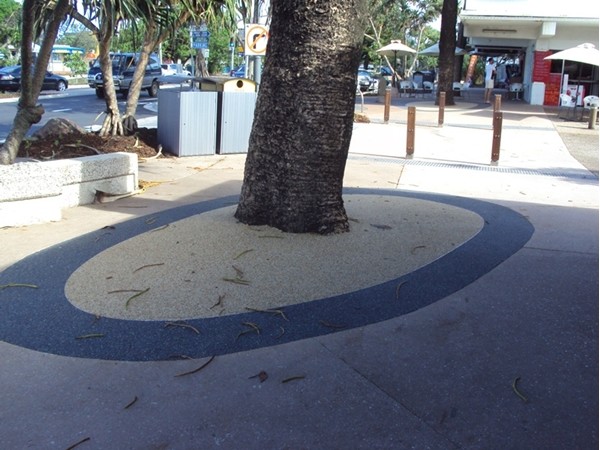With much of Australia’s urban environment paved in an impermeable skin of concrete, stone and other materials, consequences like flash flooding and urban heat problems have grown in prevalence.
Planning authorities are progressively regulating in step with these issues, particularly around storm water management. Councils, for example, are requiring that greater percentages of sites under development be ‘soft landscaped area’.
In many cases, ‘permeable paving’ will meet or exceed the requirements, be it pavers with porous material between, special pavers or gravel stabilised with epoxy resin or other bonding agents. Whatever the product specified, experts point out it’s critical that adequate drainage be installed with permeable paving.
The result is often something more akin to a natural landscape, as the water may pass through to underlying structures before infiltration into the water table, or to be redirected.
A major advantage is that the systems can function without compromising the amenity of above-lying floor area, with products available to suit everything from lightweight requirements for covering areas around tree roots and roof gardens to heavy duty durability for car parks and driveways.
Other benefits include erosion control, creating low-maintenance floor areas and eliminating tree roots from lifting and cracking concrete pathways.
Australian firms like Place Design Group in Queensland are making excellent use of the products.
"Wherever possible in the external environs we look to use materials that allow surface water to penetrate back into the ground,” design manager Shaun Egan explains. “In larger civic spaces and especially around existing trees, using a porous pavement is a big advantage as it will allow additional water to infiltrate down to the plants root system rather than the impervious concretes of tiles.
“These materials are usually smaller pebbles bonded together with resins, producing pockets between, which allow water through,” he says.
Such applications have the added benefit of still providing a hard wearing, trafficable surface.

Loose laid granite setts are another preferred option for Egan.
“In company with this we still provide “air vents” (pipes filled with gravel) from the surface down into the tree roots, to allow oxygen and additional water of fertilisers to reach the root zone,” he adds. “The porous pavement is also helpful as it provides a stable and secure surface for pedestrians, and allows all of the space to be utilised. As a result we are helping to reduce the latent heat loads by creating healthier trees and increasing shade to the footpaths and plazas."
One popular porous stone and resin solution on the market comes from StoneSet. They use a wide range of stone from river gravel to crushed rock. The crushed rock range is tested to meet and exceed the Class V rating for Slip Resistance required for public access areas of paving.
This kind of product can be installed directly over existing surfaces such as concrete, asphalt or even blocks. The flexible structure can handle cracked concrete and pavers, making it a quick option for renovating old driveways, pathways and commercial paving.
Another widely used option is Waterpave’s Sudscape, its own patented resin-bonded continuous porous paving system, which the company markets as environmentally-friendly. Voids in the rubber base retain the water until it can naturally drain back into the water table.
Aesthetics-wise, these products can be specified in range of natural stone colours and provide continuous and flexible cover with no expansion joints.
Another design practice at the forefront in applying the technology is HBO+EMTB, which recently used Hydroston 80 porous pavers in a large car park in Sydney’s east and in Melbourne’s west. At both locations the bulk of stormwater collected is directed to tree pits where it irrigates street trees with the excess draining through porous paving to the sand below.
Principal landscape architect Darren Mansfield says, “In the eastern suburbs of Sydney a lot of development occurs over the extensive Botany Bay aquifer. As landscape architects it is important to consider simple ways to replenish this and to prevent its contamination. Solutions like porous pavers are part of the tool kit we use to achieve this.”
Another option for permanent paved areas is the interlocking Ecotrihex paver produced by Adbr i Masonry in Australia. The system consists of permeable surface overlaying permeable base and sub-base materials.
A good source of further information , including technical papers and guidelines relating to concrete permeable paving, is available from the Concrete Masonry Association of Australia website.

There are also total stormwater management system alternatives, such as the Flo-Grid permeable paver from Atlantis , which supports applications on surfaces such as as patios, walkways, driveways, fire lanes and parking areas.

